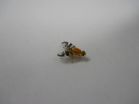(Press-News.org) Nearly one out of four older Americans say that either they or a family member have experienced excessive or unwanted medical treatment, according to the latest issue of The Gerontological Society of America's Public Policy & Aging Report (PP&AR), which goes on to show that Americans strongly support holding doctors accountable when they fail to honor patients' end-of-life health care wishes.
This PP&AR, titled "Advanced Illness Care: Issues and Options," features 12 articles that present new ways of understanding the complexity of securing appropriate advanced illness care and the decision-making dilemmas it presents. It also provides a valuable benefit by reviewing specific programs, demonstrations, and tools that family members and providers can use in providing care to persons with advanced illness. These models are person- and family-centered, and preliminary evaluations find that they may be cost-effective as well. Support for the publication was provided by Compassion & Choices.
"It is important to ensure that patients and their wishes are what drive the health care system, particularly at the end of life," said Daniel R. Wilson, the national and federal programs director for Compassion & Choices. "We were pleased to partner with The Gerontological Society of America to publish this issue of the PP&AR, which includes cutting edge writers and thinkers in the advanced illness and end-of-life field."
Advanced illness is defined as the period of illness when functioning and quality of life decline and where the efficacy of continued treatment is open to both medical and ethical question. Yet, as illness becomes more debilitating, clinical interventions often become more frequent. Studies show that the average Medicare beneficiary with one or more chronic conditions sees eight different physicians each year. It is at this stage when the medicalization of health care tends to overtake and overwhelm the needs and wishes of patients themselves. Advanced illness, due to disease, chronic conditions, or disability, can happen to anyone at any age. However, the vast majority of people with advanced illness are older than 65.
"Recent experience and studies make clear that well-informed individuals and their families often choose less care, in less institutional settings, often resulting in improved quality of life," state Robert B. Hudson, PhD, and Brian W. Lindberg, MMHS, in their introduction to the issue. "It has become clear that palliative care and hospice care are often not provided soon enough, and that in-depth conversations with persons with advanced illness can help articulate treatment and life-style preferences that the health care system has often ignored or missed."
Among the discussion of new models and tools that have been developed in recent years to better address advanced illness dilemmas and decisions, Charles Sabatino, JD, the director of the American Bar Association's Commission on Law and Aging, highlights more than a dozen resources for updating and codifying preferences. He lists these under four headings: getting the conversation going, comprehensive advance planning tools, guides focusing on certain illnesses or decisions, and advance directive registries.
The new PP&AR comes on the heels of a major report released by the Institute of Medicine this fall, which was titled "Dying in America: Improving Quality and Honoring Individual Preferences Near the End of Life." Its findings demonstrated that improving the quality and availability of medical and social services for patients and their families could not only enhance quality of life through the end of life, but may also contribute to a more sustainable care system.
INFORMATION:
Public Policy & Aging Report is a publication of the National Academy on an Aging Society, the policy branch of The Gerontological Society of America (GSA). As the nation's oldest and largest interdisciplinary organization devoted to research, education, and practice in the field of aging, GSA's principal mission — and that of its 5,500+ members — is to advance the study of aging and disseminate information among scientists, decision makers, and the general public. GSA's structure also includes an educational branch, the Association for Gerontology in Higher Education.
Advance directives can benefit patients, families, and health care system
2014-10-31
ELSE PRESS RELEASES FROM THIS DATE:
A new generation of storage -- ring
2014-10-31
A bright synchrotron source that emits over a wide part of the electromagnetic spectrum from the infrared to hard X-rays is currently being built in Lund, Sweden. The MAX IV facility presents a range of technical challenges for the team putting together its component parts in a storage - ring synchrotron system that will have a circumference of just a few hundred metres. Nevertheless, if these various challenges can be addressed then an entirely new class of experiments that require source brightness and transverse coherence will be possible.
Pedro Tavares and colleagues ...
Viewing cancer on the move: New device yields close-up look at metastasis
2014-10-31
Johns Hopkins engineers have invented a lab device to give cancer researchers an unprecedented microscopic look at metastasis, the complex way that tumor cells spread through the body, causing more than 90 percent of cancer-related deaths. By shedding light on precisely how tumor cells travel, the device could uncover new ways to keep cancer in check.
The inventors, from the university's Whiting School of Engineering and its Institute for NanoBioTechnology (INBT), published details and images from their new system recently in the journal Cancer Research. Their article ...
Lack of oxygen delayed the rise of animals on Earth
2014-10-31
New Haven, Conn. – Geologists are letting the air out of a nagging mystery about the development of animal life on Earth.
Scientists have long speculated as to why animal species didn't flourish sooner, once sufficient oxygen covered the Earth's surface. Animals began to prosper at the end of the Proterozoic period, about 800 million years ago — but what about the billion-year stretch before that, when most researchers think there also was plenty of oxygen?
Well, it seems the air wasn't so great then, after all.
In a study published Oct. 30 in Science, ...
NASA sees remnants of Nilofar go to cyclone graveyard
2014-10-31
Wind shear has caused the demise of former Tropical Cyclone Nilofar in the northern Arabian Sea. NASA's Aqua satellite passed over Nilofar on Oct. 31 and captured an image that shows strong wind shear has pushed the bulk of clouds and showers away from Nilofar's center, basically sending the storm to its grave.
The Moderate Resolution Imaging Spectroradiometer aboard NASA's Aqua satellite captured an image of the remnants of Tropical Cyclone Nilofar on Oct. 31 at 08:45 UTC (4:45 a.m. EDT). The image showed that the former tropical cyclone's clouds and showers were pushed ...
Proton therapy shown to be less costly than some alternative radiotherapy techniques
2014-10-31
In terms of duration of treatment and cost, patients with early stage breast cancer may benefit from accelerated partial breast irradiation (APBI) with proton therapy versus whole breast irradiation (WBI), according to new research from The University of Texas MD Anderson Proton Therapy Center.
In a cost analysis study based on typical patient characteristics, researchers used Medicare reimbursement codes to analyze allowable charges for eight different types of partial and whole breast irradiation therapies and treatment schedules available to early stage breast cancer ...
Green spaces don't ensure biodiversity in urban areas
2014-10-31
Planting trees and creating green space in cities is good for attracting species, but it may not be enough to ensure biodiversity in built environments, a University of Iowa study has found.
The researchers surveyed two types of tree in an urban area in Iowa, and recorded the abundance of two insects that interact with them. They found that while there were plenty of the trees, black cherry and black walnut, they didn't find a corresponding abundance of the insects, in this case fruit flies that feed on the walnuts and black cherries and a type of wasp that feeds on the ...
Improved mouse model will accelerate research on potential Ebola vaccines, treatments
2014-10-31
In the war against Ebola one important hurdle has just been cleared – by a mouse.
Researchers at the University of North Carolina at Chapel Hill and colleagues have developed the first genetic strain of mice that can be infected with Ebola and display symptoms similar to those that humans experience. This work, published in the current issue of Science, will significantly improve basic research on Ebola treatments and vaccines, which are desperately needed to curb the worldwide public health and economic toll of the disease.
"You can't look for a cure for Ebola ...
Scientists trigger self-destruct switch in lung cancer cells
2014-10-31
CANCER RESEARCH UK scientists have found a drug combination that can trigger the self-destruct process in lung cancer cells - paving the way for new treatments, according to research that will be presented at the National Cancer Research Institute (NCRI) Cancer Conference in Liverpool next week*.
When healthy cells are no longer useful they initiate a chain of events culminating in self destruction. But cancer cells swerve away from this suicide path and become immortal. This means that cells grow out of control – causing tumours to form.
The Cancer Research UK ...
Tropical Depression Nuri now haunting the western Pacific Ocean
2014-10-31
Tropical Depression Nuri formed on Halloween morning, October 31, and is haunting the waters of the western North Pacific Ocean. NASA-NOAA's Suomi NPP satellite captured a ghostly-white image of the storm.
When Suomi NPP flew over Tropical Depression Nuri on Oct. 31 at 3:36 UTC, the Visible Infrared Imaging Radiometer Suite or VIIRS instrument aboard captured an infrared image of the storm. The infrared data shows temperature, an indicated that there were very high thunderstorms with very cold cloud top temperatures surrounding the center of the low level circulation ...
Strange, fanged deer persists in Afghanistan
2014-10-31
WCS study confirms that endangered musk deer still live in Nuristan Province – some 60 years after last sighting
Species targeted by poachers: Musk deer scent glands are more valuable than gold
Study appears in the October issue of the journal Oryx
NEW YORK (October 31, 2014) – More than 60 years after its last confirmed sighting, a strange deer with vampire-like fangs still persists in the rugged forested slopes of northeast Afghanistan according to a research team led by the Wildlife Conservation Society (WCS), which confirmed the species presence during ...







